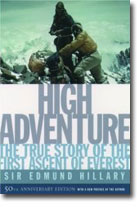Books |
High Adventure
Edmund Hillary
By
Published: Jan 01, 2007
Category:
Memoir
He didn’t see a mountain until he was 16, didn’t climb one until he was 20. But there were personal mountains to climb in Edmund Hillary’s childhood, and his father — a professional beekeeper in New Zealand — made sure he climbed them all.
When young Ed was sick, his father put him on a starvation diet until he was well again.
When Ed was ready for school, his father declined to provide him with shoes.
And when Ed wanted to buy something — no matter how small — his father made him earn the money.
Instead of complaining, Edmund Hillary walked — barefoot — to school. At harvest time, he stayed home to lug 80 to 120-pound crates of honey. But there was a price for his loyalty to family; when he went to college, he was an outsider. “By the end of my two years I hadn’t passed a single examination and I didn’t have a single friend,” he writes. He did, however, have a little money — instead of using the meager transportation allowance his father gave him, he jogged to school, five miles each way — and he used that money to take a short vacation in New Zealand’s mountains.
There he discovered a powerful motivator to take up climbing. Two young men entered the hotel lounge, accompanied by whispers: “They’ve just climbed Mount Cook.” In minutes, “pretty girls fluttered around them like moths drawn to a flame.” Hillary was overwhelmed by “the dull nature of my existence. These chaps were getting some excitement out of life.” And so he resolved: “Tomorrow I must climb something!”
And there you have the makings of the first man to conquer Everest: physical strength, uncommon endurance, a large capacity for discomfort, a deep desire to be worthy of a woman’s attention.
The climb is a fantastic story, and no one tells it better. At 27,400 feet, sixty-pound packs felt like lead; “Every step required a conscious breathing effort. Every thirty or forty steps, we’d stop and rest, with our chests on our bent knee to give our backs and lungs a change to recover. Time seemed to have lost its meaning….” But nothing could stop Hillary and his Tibetan partner. At 11:30 AM on May 29, 1953, they stood at Everest’s summit.
When you’ve achieved the impossible, what do you do with the rest of your life?
Hillary was one of the lucky champions — he knew himself. And so, after a few more adventures, he became a humanitarian. Through the Himalayan Trust, he raised funds to build a three-room school; before he was finished, he was responsible for two Nepalese hospitals, a dozen clinics and thirty schools. (In Nepal he also suffered the greatest loss he would ever know — the death, in a plane crash, of his wife and sixteen-year-old daughter.)
Fifty-plus years after Hillary’s triumph, mountaineering has turned into a business. Thanks to greatly improved climbing supplies, almost anyone can climb Everest now. And almost anyone does — the mountain is littered with aluminum ladders, thousands of feet of fixed rope, discarded oxygen bottles, tents and food containers.
So what, now, does Hillary see as his greatest achievement? “The building of schools and medical clinics.”
And conquering Everest? “A footprint on a mountain."
But Everest did reveal something profound to Hillary: “It is not the mountains that we conquer, but ourselves.”
A man who can say that has written a book that should be addictive reading for explorers real and armchair.
To buy “High Adventure” from Amazon.com, click here.


